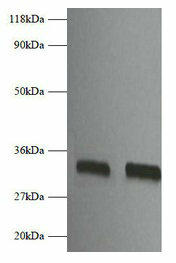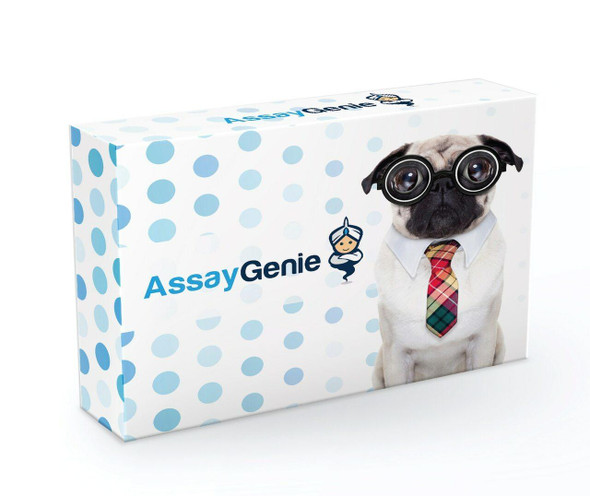Fgf2 Antibody (PACO32136)
- SKU:
- PACO32136
- Product type:
- Antibody
- Reactivity:
- Mouse
- Human
- Host Species:
- Rabbit
- Isotype:
- IgG
- Application:
- ELISA
- Application:
- WB
- Antibody type:
- Polyclonal
- Conjugation:
- Unconjugated
Description
| Antibody Name: | Fgf2 Antibody (PACO32136) |
| Antibody SKU: | PACO32136 |
| Size: | 50ug |
| Host Species: | Rabbit |
| Tested Applications: | ELISA, WB |
| Recommended Dilutions: | ELISA:1:2000-1:10000, WB:1:1000-1:5000 |
| Species Reactivity: | Mouse, Human |
| Immunogen: | Recombinant Mouse Fibroblast growth factor 2 protein (10-154AA) |
| Form: | Liquid |
| Storage Buffer: | Preservative: 0.03% Proclin 300 Constituents: 50% Glycerol, 0.01M PBS, PH 7.4 |
| Purification Method: | >95%, Protein G purified |
| Clonality: | Polyclonal |
| Isotype: | IgG |
| Conjugate: | Non-conjugated |
 | Western blot All lanes: Fgf2 antibody at 2µg/ml Lane 1: EC109 whole cell lysate Lane 2: 293T whole cell lysate Secondary Goat polyclonal to rabbit IgG at 1/10000 dilution Predicted band size: 18 kDa Observed band size: 32 kDa . |
| Background: | Plays an important role in the regulation of cell survival, cell division, angiogenesis, cell differentiation and cell migration. Functions as potent mitogen in vitro. |
| Synonyms: | Fibroblast growth factor 2 (FGF-2) (Basic fibroblast growth factor) (bFGF) (Heparin-binding growth factor 2) (HBGF-2), Fgf2, Fgf-2 |
| UniProt Protein Function: | FGF2: Plays an important role in the regulation of cell survival, cell division, angiogenesis, cell differentiation and cell migration. Functions as potent mitogen in vitro. Monomer. Homodimer. Interacts with FGFR1, FGFR2, FGFR3 and FGFR4. Affinity between fibroblast growth factors (FGFs) and their receptors is increased by heparan sulfate glycosaminoglycans that function as coreceptors. Interacts with CSPG4, FGFBP1 and TEC. Found in a complex with FGFBP1, FGF1 and FGF2. Expressed in granulosa and cumulus cells. Expressed in hepatocellular carcinoma cells, but not in non- cancerous liver tissue. Belongs to the heparin-binding growth factors family. 4 isoforms of the human protein are produced by alternative initiation. |
| UniProt Protein Details: | Protein type:Activator; Motility/polarity/chemotaxis Cellular Component: extracellular space; cytoplasm; extracellular region; nucleus; cytosol Molecular Function:heparin binding; protein binding; ligand-dependent nuclear receptor transcription coactivator activity; growth factor activity; cytokine activity; chemoattractant activity; receptor binding; fibroblast growth factor receptor binding Biological Process: wound healing; activation of MAPKK activity; regulation of cell cycle; multicellular organismal development; positive regulation of transcription, DNA-dependent; positive regulation of smooth muscle cell proliferation; adrenocorticotropin hormone secreting cell differentiation; cardiac muscle cell proliferation; thyroid stimulating hormone secreting cell differentiation; hyaluronan catabolic process; growth factor dependent regulation of satellite cell proliferation; embryonic development ending in birth or egg hatching; positive regulation of MAP kinase activity; negative regulation of cell proliferation; substantia nigra development; glial cell differentiation; positive chemotaxis; induction of an organ; positive regulation of cell proliferation; regulation of retinal cell programmed cell death; response to axon injury; angiogenesis; cell differentiation; positive regulation of granule cell precursor proliferation; positive regulation of cardiac muscle cell proliferation; fibroblast growth factor receptor signaling pathway; positive regulation of cell fate specification; positive regulation of blood vessel endothelial cell migration; positive regulation of phosphoinositide 3-kinase activity; negative regulation of blood vessel endothelial cell migration; positive regulation of protein kinase B signaling cascade; positive regulation of osteoblast differentiation; positive regulation of angiogenesis; stem cell development; cell migration during sprouting angiogenesis; ureteric bud branching; positive regulation of cell division; release of sequestered calcium ion into cytosol; phosphatidylinositol biosynthetic process; positive regulation of endothelial cell proliferation; positive regulation of transcription from RNA polymerase II promoter; positive regulation of protein amino acid phosphorylation; positive regulation of cell differentiation; inositol phosphate biosynthetic process; positive regulation of epithelial cell proliferation; lung development |
| UniProt Code: | P15655 |
| NCBI GenInfo Identifier: | 122743 |
| NCBI Gene ID: | 14173 |
| NCBI Accession: | P15655.1 |
| UniProt Related Accession: | P15655 |
| Molecular Weight: | 17,153 Da |
| NCBI Full Name: | Fibroblast growth factor 2 |
| NCBI Synonym Full Names: | fibroblast growth factor 2 |
| NCBI Official Symbol: | Fgf2 |
| NCBI Official Synonym Symbols: | Fgfb; bFGF; Fgf-2 |
| NCBI Protein Information: | fibroblast growth factor 2; HBGF-2; basic fibroblast growth factor; heparin-binding growth factor 2 |
| UniProt Protein Name: | Fibroblast growth factor 2 |
| UniProt Synonym Protein Names: | Basic fibroblast growth factor; bFGF; Heparin-binding growth factor 2; HBGF-2 |
| Protein Family: | Fibroblast growth factor |
| UniProt Gene Name: | Fgf2 |
| UniProt Entry Name: | FGF2_MOUSE |
| ELISA Kits |
| Mouse FGF basic / FGF2 / Basic Fibroblast Growth Factor ELISA Kit |
| Mouse bFGF/FGF2 (Basic Fibroblast Growth Factor) CLIA Kit (MOES00108) |
| Mouse Heparin-binding growth factor 2 (Fgf2) ELISA Kit |
| Secondary Antibody |
| Anti-HRP Goat Anti-Rabbit IgG (H+L) Antibody (CABS014) |
| Recommended Products |
| Anti-FITC Goat Anti-Rabbit IgG (H+L) Antibody (CABS011) |
| Anti-HRP-conjugated Beta Actin Antibody (CABC028) |





